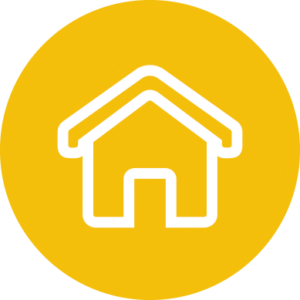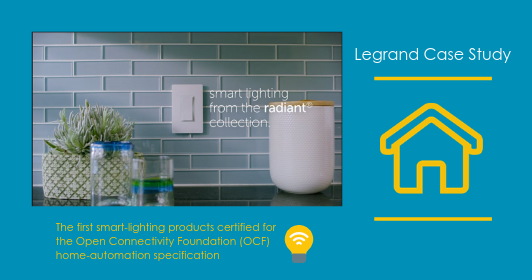Open Connectivity Foundation Member, Legrand, Releases First OCF-Certified Smart Lighting
Making Home Automation Real and Easily Attainable
Wouldn’t it be wonderful to come home at the end of the day to a house that has adjusted the thermostat to your preference and turned on the lights to welcome you back?
Yes, it is true, you can do this now, but it hasn’t always been this easy. In January at CES 2019, Legrand announced its Smart Lighting Controls for their Radiant Collection. The Radiant Collection incorporates Smart Lighting that is ready to connect with and seamlessly works with other OCF-certified IoT devices regardless of brand or operating system.
These lighting devices are the first to be certified from the Open Connectivity Foundation (OCF) and these smart switches, dimmers and outlets can be controlled remotely via the Legrand Smart Lights application or within the home through voice-enabled assistants like Amazon Alexa and Google Home.
“We have the smartest technology built right in,” said Brian DiBella, President, Electrical Wiring Systems at Legrand North America. “With the capability of connecting smart devices from other manufacturers, homeowners simply speak commands and enable activation of doors, thermostats, and lighting for an entire smart home experience.”
The benefits of a smart, connected world are plentiful; however, for the IoT to keep progressing and work to its fullest potential, the industry needs to unify around a single approach to connectivity. This approach to easy, out-of-the-box connectivity is in line with Legrand and OCF’s commitment to developing products that are open, interoperable and secure.
Why OCF’s Smart Home Specification?
As Mr. DiBella explains, the Internet has been around for several decades and there is a clear blueprint established in terms of what works, what hasn’t worked, and how to do it.
Legrand’s IoT approach is to follow in the footsteps of Internet technologies that are proven and analyzed, showing how they have held up over time.
In the early days of the Internet, you dialed into the Internet via service providers such as AOL, Prodigy, CompuServe. These services were proprietary and provided closed environments that did not allow for much innovation.
The standards, however that were established such as IP addresses and the HTML common language helped move the Internet forward.
Mr. DiBella describes how In the IoT world, the OCF specification is the HTML of the “physical things world.” OCF provides an open platform where you don’t have to worry about a new piece of hardware requiring you to write a special driver that will interact correctly or need to change other parts of the system. OCF takes away this cumbersome process of making changes that fit with proprietary protocols.
Contemporary Solutions: The Great Period of Unification
Again, having a single unified approach to securing communications in IoT is the direction the industry must go. The benefits of unification are solutions that are developed with security in mind and “We need to democratize IoT interoperability so that everyone can play, and they have a set of clear rules and the confidence that it’s going to work the way ‘things’ are supposed to,” said DiBella. The industry needs a protocol that will make IoT a reality and OCF is making this real – it’s making the bridge that is needed for devices to communicate securely and seamlessly.”
The Remote Challenge: Establishing Control of the Smart Home
SURE Universal delivers first Open Connectivity Foundation Certified mobile universal remote to enable simpler control of smart home appliances and electronics
Executive Summary
Whether it’s a physical remote or a smartphone application that controls technology linked to the home network, the problem is still the same – too many remotes to control all the devices in the home.
SURE Universal Remote leverages the depth of the OCF specification and breadth of the OCF ecosystem to become the number one mobile application universal remote for Smart Home and Internet of Things (IoT) devices.
“Everything Old Is New Again.”
The idea of a universal remote, one device to control multiple appliances (e.g. television, audio, and cable) is nothing new. For decades, multiple companies have created remotes to help consumers reduce the number of brand-specific remotes that would inevitably get wedged between the living room couch cushions.
As IoT moves out of the living room and becomes more prevalent throughout the entire home, consumers are finding it easier to integrate devices into their home network, giving them greater ability to control their home environment.
Now they are facing a new challenge – how to easily control the growing number of the devices in their smart home. Device manufacturers offer ways to communicate with the device as a matter of convenience, but as more devices connect to the home network, consumers must navigate an increasing number of different applications to interact with their smart home.
Adding to this challenge is the fact that it is rare for a consumer to have smart home devices from the same manufacturer. For example, a home may have three televisions from different manufactures, resulting in not only three physical remotes but also three different smartphone apps. And then there is the added challenge of all the other devices that connect with the television – cable, audio components, streaming devices, game consoles and BlueRay players. There’s a different app for one brand of television, and another for the streaming media service, each with their own unique features.
The end result is that consumers have an ever increasing number of remotes to keep track of and no streamlined way to connect and interact with all the devices in their home. How can smart home consumers sort through the mass of control options without getting lost in the smart home’s “virtual cushions?”

SURE Universal Remote Restores Control to the Consumer
SURE Universal, formerly known as Tekoia Ltd., has simplified all of these challenges and provided consumers with the smart home experience they expect, all due to the Open Connectivity Foundation’s single standard for secure interoperability.
For Tekoia founder and CEO Viktor Ariel, having too many remotes in the home is a problem, defeating much of the promise of the IoT. Realizing that almost everyone has access to a smartphone, and that they carry it with them everywhere, Ariel set out to develop a software solution that allows IoT enabled devices to be controlled on one integrated platform. Whether it’s a smart home device connected to a Wi-Fi router or a legacy home appliance that uses Infra-Red (IR), SURE Universal Remote allows customers to integrate and control all of their devices from their smartphone.
SURE Universal Remote is able to support millions of appliances, from smart televisions and media streaming devices to air conditioning units, lighting fixtures and home security solutions. Conveniently controlled by one application, the SURE Universal Remote offers consumers a way to directly connect to all of these devices without having to search across their smartphone, flipping from app to app just to adjust the volume and change the channel.
How Has OCF Helped?
“OCF has provided us with the foundation to be the only universal software remote today with the ability to solve consumer’s interoperability challenges.” said Shiri Ram, Director of Marketing for Tekoia Ltd., manufacturer of the SURE Universal Remote.
In December of 2016, SURE Universal Remote became the first, and only, OCF Certified mobile remote. Key to that certification, and helping consumers regain control of their smart home, remains OCF’s primary focus – secure interoperability that just works.
Because so many of the industries’ leading technology companies are supporting OCF’s specifications and working to certify their products to OCF standards, SURE Universal Remote is able communicate with a wide range of IoT devices, regardless of the manufacturer.
“The OCF specification creates a naming format that allows IoT device manufacturers, regardless of the industry, to communicate.” said Ram. “As an OCF member, we all follow the standards and as a result devices can communicate with and trust each other.”
Results
The SURE Universal Remote is offered free of charge and currently ranks first in the Android marketplace. With over 20 million downloads worldwide, SURE Universal Remote is well positioned to help consumers experience the smart home as it was intended.
SURE Universal continues to leverage the OCF specification and standards to increase its service offerings and meet the growing IoT needs of the smart home. Recently featured at the 2017 Consumer Electronics Show SURE Universal, along with other OCF partners Intel and Samsung, demonstrated the growing potential of the SURE Universal platform by leveraging OCF’s Open API to integrate a SURE Thing device server, the SURE Universal Remote client and SURE Cloud subscription and advertising revenue database.
Finally, with the scope of its install base across a number of consumer platforms, SURE Universal is able to help other OCF Certified manufactures better understand their end users in order to improve product functionality and offer additional services. Building on OCF’s common data model, SURE Universal is able to provide randomized information regarding consumer’s IoT needs to manufacturers, and in return, enabling consumers to receive ads relevant to their smart home needs.
Summary
By enabling common device discovery and common data models, all built on a robust security framework, the Open Connectivity Foundation allows companies like SURE Universal to simplify and deliver the smart home experience customers want, all without losing control.
